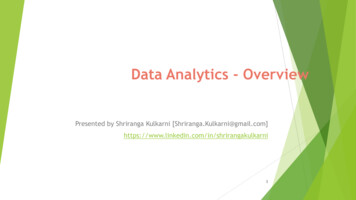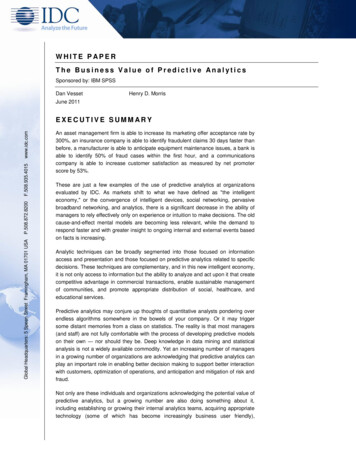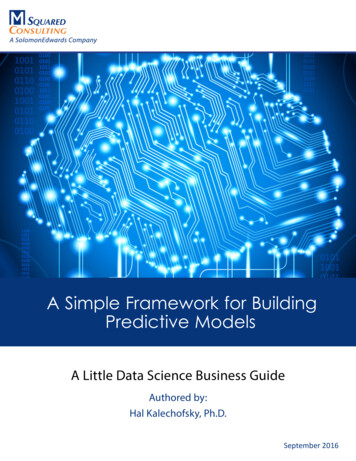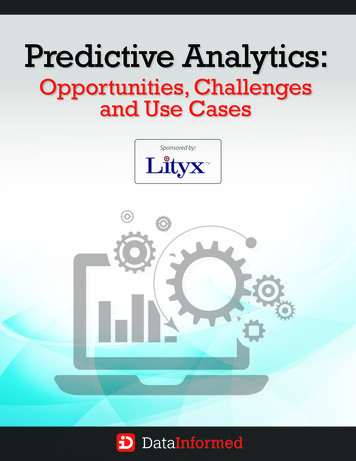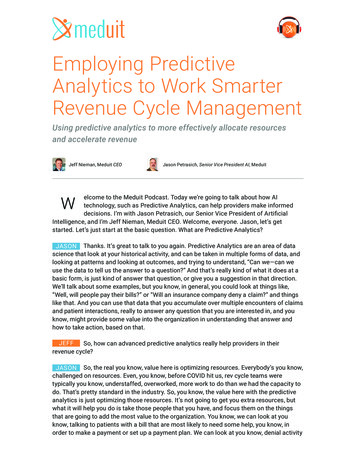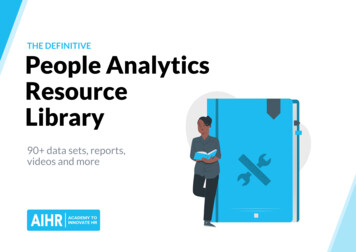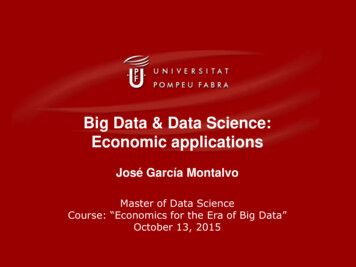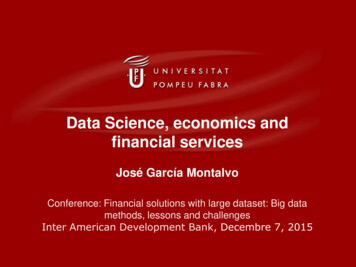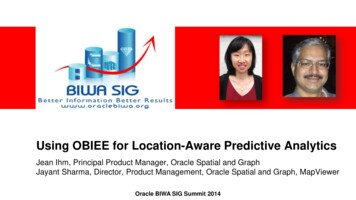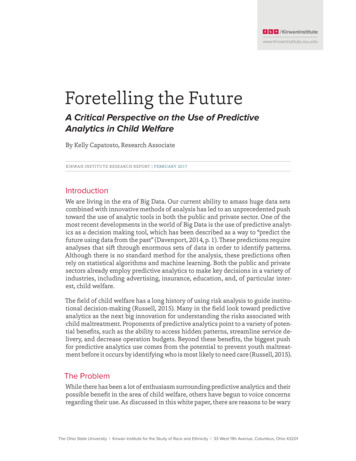
Transcription
ling the FutureA Critical Perspective on the Use of PredictiveAnalytics in Child WelfareBy Kelly Capatosto, Research AssociateKIRWAN INSTITUTE RESEARCH REPORT FEBRUARY 2017IntroductionWe are living in the era of Big Data. Our current ability to amass huge data setscombined with innovative methods of analysis has led to an unprecedented pushtoward the use of analytic tools in both the public and private sector. One of themost recent developments in the world of Big Data is the use of predictive analytics as a decision making tool, which has been described as a way to “predict thefuture using data from the past” (Davenport, 2014, p. 1). These predictions requireanalyses that sift through enormous sets of data in order to identify patterns.Although there is no standard method for the analysis, these predictions oftenrely on statistical algorithms and machine learning. Both the public and privatesectors already employ predictive analytics to make key decisions in a variety ofindustries, including advertising, insurance, education, and, of particular interest, child welfare.The field of child welfare has a long history of using risk analysis to guide institutional decision-making (Russell, 2015). Many in the field look toward predictiveanalytics as the next big innovation for understanding the risks associated withchild maltreatment. Proponents of predictive analytics point to a variety of potential benefits, such as the ability to access hidden patterns, streamline service delivery, and decrease operation budgets. Beyond these benefits, the biggest pushfor predictive analytics use comes from the potential to prevent youth maltreatment before it occurs by identifying who is most likely to need care (Russell, 2015).The ProblemWhile there has been a lot of enthusiasm surrounding predictive analytics and theirpossible benefit in the area of child welfare, others have begun to voice concernsregarding their use. As discussed in this white paper, there are reasons to be waryThe Ohio State University Kirwan Institute for the Study of Race and Ethnicity 33 West 11th Avenue, Columbus, Ohio 43201
Kirwan Institute Research Report February 2017of the widespread use of predictive analytics. The risk of perpetuating cognitiveand structural biases is among them. While this white paper does not to condemnthe use of predictive analytics, it does hope to promote a critical assessment ofthese tools and the emergence of other Big Data applications.A Perspective on Predictive Analyticsthat is Uniquely KirwanAt the Kirwan Institute for the Study of Race and Ethnicity, our mission is to ensurethat all people and communities have the opportunity to succeed. Through thiswork, the Institute developed a framework for analyzing inequity that considersboth 1) cognitive and 2) structural barriers, defined below. In tandem, the operation of these barriers explains how inequity can persist in various institutions andsystems, even in the absence of intentional prejudice or discrimination.Cognitive Barriers: The role of individual-levelthoughts and actions in maintaining structures ofinequity.Structural Barriers: The influence of history onpolicies, practices, and values that perpetuateinequity (Davies, Reece, Rogers, & Rudd).Rather than focusing on explicit, intentionaldiscrimination, the Kirwan Institute highlights theimportance of implicit bias and other unconsciouspsychological processes. Generally, implicit biasis understood as the automatically activatedevaluations or stereotypes that affect individual’sunderstanding, actions, and decisions in anunconscious manner (Staats, 2013). All humansexhibit implicit bias, and having these biases doesnot reflect the intent to cause harm.Although our society has made efforts to addressracism, sexism, and other forms of discrimination,our nation’s institutions remain rooted in a legacyof legally endorsed discrimination. For example,redlining—which purposefully devalued homesin minority neighborhoods by limiting accessto financing—was a common practice until theFair Housing Act of 1968 was passed (Olinger,Capatosto, & McKay, 2016). The enduring harmfulimpact of these practices is evident in the racialdisparities found in the current housing landscape.Thus, by considering both social forces—structural and cognitive, this white paperaims to do the following: Uplift concerns related to the use of predictive analytics in child welfareand other systems Examine concerns according to the inputs, outputs and application ofpredictive analytics Propose suggestions for the future of predictive analytics in child welfare2
Kirwan Institute Research Report February 2017Concerns Related to the Use of Predictive Analyticsin the Child Welfare SystemModels of predictive analytics proceed in three stages. First, data goes into themodel. Second, the model, with algorithms and/or statistical analyses, createsan output. Finally, individuals apply the model’s outputs to decision-making atthe field level. The following analysis critically examines concerns at each stageof this process—the inputs, outputs, and application of these models—regardingcognitive and structural factors that could be at play.InputsCognitive: Humans Encode Cognitive Biases into Machines“Our own values and desires influence our choices, from the data we choose to collectto the questions we ask. Models are opinions embedded in mathematics.”– Cathy O’Neil, Weapons of Math Destruction, 2016All humans rely on a variety of automatic mental processes to make sense of theworld around us. One example of these processes is the operation of implicit biases.People are typically unaware of the implicit biases they possess, and these biasesoften do not align with one’s explicit intentions to be egalitarian (Greenwald &Krieger, 2006; Nosek & Hansen, 2008). As such, all people make decisions that unintentionally rely on faulty or biased information. These decisions can have hugeramifications for our ability to safeguard opportunities for individuals of variousgenders, races, and ability statuses. To illustrate, one study demonstrated thatresumes with White sounding names were nearly 50% more likely to get a callback than resumes with Black sounding names, despite controlling for all otherfactors, including work experience (Bertrand & Mullainathan, 2004).As research continues to demonstrate how human bias can disrupt attempts toachieve equity, many have looked to the use of technology to ensure that decisionsare made more objectively. Predictive analytics, like other data-based decision-making tools, have received considerable support for their potential to combat biasesand provide opportunities for marginalized groups (Federal Trade Commission,2016). However, human beings encode our values, beliefs, and biases into theseanalytic tools by determining what data is used and for what purpose. The datathat institutions choose to use reveal what variables and reporting mechanismare valued most.The advancement in technology has certainly improved the ability of child welfaresystems to harness data to prevent child abuse and neglect. Large-scale data collection and reporting have made it easier than ever to manage cases and communicate among child welfare agencies. Despite this overall progress, the quality andconsistency of the data used within the child welfare system remains an area ofconcern (Russell, 2015). Much of the data that predictive analytics tools use arederived from field-level reports. These may include self-reports on a variety of so-3
Kirwan Institute Research Report February 2017cioemotional factors or clinician reports on a child’s background and intake experience (Commission to Eliminate Child Abuse and Neglect Fatalities, 2014). Itis impossible to remove all subjectivity from personal reporting tools. Moreover,those who work in child welfare are often working in environments of high ambiguity, time constraints, and stress—all of which increase the likelihood of relyingon implicit factors during decision-making (in general, see Mitchell, Banaji, &Nosek, 2003; Van Knippenberg, Dijksterhuis, & Vermeulen, 1999). As such, it iscritical to acknowledge that human biases can limit the integrity of the data thatinforms predictive analytic models.Structural: Previous Marginalization as a Predictor for Future Risk“The math-powered applications powering the data economy were based on choicesmade by fallible human beings. Some of these choices were no doubt made with thebest intentions. Nevertheless, many of these models encoded human prejudice, misunderstanding, and bias into the software systems that increasingly managed our lives.”– Cathy O’Neil, Weapons of Math Destruction, 2016The adage “garbage in, garbage out” never holds truer than in the field of predictiveanalytics. When determining the inputs for these analyses, it is almost impossibleto avoid incorporating longstanding patterns of inequity that exist in our society.Yet it may be difficult to identify where these patterns originate. For example, somepredictive models currently used in the child welfare system assign a numeric indicator of risk associated with youth outcomes. In some cases, this risk informshow likely the child is to be reunited with the family, or how resilient the child is(Russell, 2015; Sledjeski, Dierker, Brigham, & Breslin, 2008; Toche-Manley, Dietzen,Nankin, & Beigel, 2013). Builders of such models would almost certainly avoidovert, illegal discrimination such as reliance on data that linked a family’s raceto the probability of child maltreatment or the assignment of a higher risk ratingfor racial minorities. However, because of past discrimination and historical inequities, subtle biases can emerge when seemingly “race neutral” data acts as aproxy for social categories. For example, data related to neighborhood characteristics are profoundly connected to historic practices of racial exclusion and discrimination. Thus personal information, such as one’s zip code or diet, are deeplyconnected to racial identity (Sen & Wasow, 2016). Data that is ostensibly used torate risk to child well-being can serve as a proxy for race or other past oppression,thereby over-representing those who have suffered from past marginalization asmore risky. In this way, poor and marginalized communities are often disproportionately penalized by rating systems, even if the data feeding into these modelswould take considerable—perhaps, unreasonable—time and effort to alter, suchas changing one’s credit score or zip code (O’Neil, 2016).Even more troubling is the omission of information for youth who do not enter thechild welfare system as a counterbalance for these predictions of risk. It is impossible to know how many children who are never maltreated and whom would notproperly be assessed as “high-risk” for maltreatment under these factors. This type4
Kirwan Institute Research Report February 2017of control group data simply does not (and should not) exist. Thus, it is importantto acknowledge that the assumptions often built into data analytic models predictmaltreatment with incomplete data.OutputsCognitive: Overconfidence in the Objectivity of Outputs“Data and data sets are not objective; they are creations of human design. We givenumbers their voice, draw inferences from them, and define their meaning throughour interpretations. Hidden biases in both the collection and analysis stages presentconsiderable risks, and are as important to the big-data equation as the numbersthemselves”– Kate Crawford, The Hidden Biases in Big Data, 2016The allure of predictive analytics is their potential for identifying and correcting forhuman biases that may arise during important child welfare decisions by lessening reliance on individual judgments. However, algorithms alone are no panaceato subjectivity. As discussed earlier, these models can unintentionally encode thesame biases reflected in our society. Thus, one of the most serious dangers of predictive analytics is our overconfidence in the objectivity of their outputs.When tools rely on vast quantities of data and complex analyses, it can be difficult or even impossible to be aware of the cognitive mechanisms influencing amodel’s predictions. For example, if field workers are required to enter a particular score related to a child’s recidivism into the foster care system, it is highly unlikely that they will have the opportunity or authority to question the objectivityof that score at a later date, or exercise the discretion to make an exception to thescore. For this reason, it can be very difficult to retroactively identify or correctinstances where these seemingly objective outputs act as a gatekeeping mechanism—steering children and families toward service options that are not a suitable match for their individual needs.Structural: Predictive Analytics Can Perpetuate Existing Structural Disparities“The creators of these new models confuse correlation with causation. They punishthe poor, and especially racial and ethnic minorities. And they back up their analysis with reams of statistics, which give them the studied air of evenhanded science.”– Cathy O’Neil, Weapons of Math Destruction, 2016Beyond relying on data inputs that reflect existing biases, predictive analytics mayalso exacerbate these structures of inequity through their outputs. For example,the tendency for algorithms to “digitally redline,” sometimes referred to as “weblining,” garnered significant attention from the federal government in the 2014Big Data report (Executive Office of the President, 2014, p. 53). In the same waythat ubiquitous redlining practices restricted loans and devalued homes in minority neighborhoods, weblining occurs when public and private institutions5
Kirwan Institute Research Report February 2017use opaque scoring algorithms to restrict communication and services to certaingroups of people.In the private sector, this most often occurs in the form of targeted advertising—matching consumers with products that the data reveals are most relevant tothem. This matching process can involve various practices such as tracking consumers’ purchase history or grouping consumers with similar attributes in order tooffer goods and services that most likely match that population. Although largelyviewed as a beneficial use of predictive analytics, targeted marketing has producedinstances of racial discrimination. In one example, a test preparation program’smarketing algorithm offered different pricing among geographic regions, whichresulted in Asian families being subjected to higher prices (Angwin, Mattu, &Larson, 2015). In another, search engine searches for Black-sounding names weremore likely to reveal advertisements offering arrest records than searches withWhite-sounding names (Sweeney, 2013). Importantly, no one intended for thesealgorithms to produce discriminatory outputs. Instead, as discussed above, thesesearch processes learned the biases from user patterns, and then played a role inperpetuating these biases through consumer behavior.A highly controversial example of predictive analytics playing out in the publicsector is targeted policing (Executive Office of the President, 2014). While someapplaud the use of predictive models for focusing limited resources on high crimeareas, the practice has been criticized for justifying an outsized police presencein poor neighborhoods with large minority populations (For a general overview,see joint statement on predictive policing: American Civil Liberties Union, 2016).Some predictive policing efforts have gone so far as to form lists and engage inactive surveillance of those deemed most likely to commit a crime (ExecutiveOffice of the President, 2014). Individual-level predictions such as these are morelikely to target people for who they are (race, proximity to crime, class, educationlevel, etc. ) rather than on the basis of observable behavior (O’Neil, 2016).Predictive analytics tools in child welfare can operate the same way as the predictive policing scenario—by classifying individuals and families based on individualrisk profiles for maltreatment. To illustrate, one predictive analytic tool utilizeddata from youth self-reports to determine the variables most related to youth resiliency. Youth received a resilience score based on 11 indicators in order to assistservice workers in developing their treatment goals (Toche-Manley et al., 2013).Even though the identification of these risk factors is empirically valid, researchhas yet to show the link between these resiliency scores and treatment outcomes.Thus, this type of scoring may have the potential to impose a punitive system ofgatekeeping on less-resilient youth who are denied opportunities more resilientyouth are routinely offered. This is just one example of predictive analytics efforts,though research-based, that may not generalize into effective field use. Moreover,if tools such as these do get utilized in the field, their application may actually perpetuate existing structural disparities by restricting necessary services to certainfamilies or neighborhoods.6
Kirwan Institute Research Report February 2017How Predictive Analytics Impact Decisions in Child WelfareThe prior sections of this paper addressed what these models encode and produce.This final section will discuss the importance of how these tools can influence decision-making in child welfare systems that reproduce inequity. Predictive analytics are already governing real-world decision-making across many social servicesfields; many of these decisions literally involve life and death. Although the KirwanInstitute strongly supports the use of data and empirical research to inform organizational behavior, it is essential to remain cautious to the potential drawbacksof how predictive analytics are applied.First, when relying on predictive analytic models, users can fall into the commontrap of confusing correlation with causation. For example, one analysis conducted in New Zealand analyzed all maltreatment cases for five-year-olds and discovered that 83% had been enrolled in the public benefit system before they were two;they concluded that the receipt of public benefits predicted future child maltreatment (Vaithianathan, Maloney, et al., 2013, p. 354). Similarly, other studies haveconcluded that prior experience with child protective services (CPS) was the bestpredictor of recurrent maltreatment (DePanfilis & Zuravin, 1999; Fluke, Shusterman, Hollinshead, & Yuan, 2008; Sledjeski et al., 2008). While this information isempirically valid and instructive for understanding the recurrent nature of childwelfare involvement, it does not provide information on the circumstances thatdetermined the families’ need for these services. Moreover, these analyses cannotconclude why youth who a) received public benefits or had CPS contact and b)did not experience maltreatment, fared better than some of their peers. Thesefindings illustrate a classic example of the adage that correlation does not equalcausation; public benefits and CPS involvement acted as confounding variablesbecause both were highly correlated to later child maltreatment, but were not theunderlying cause. In this case, the lack of a causal relationship between these riskfactors and the outcome of maltreatment should seem apparent. However, othervariables identified by these models are not held to the same standard of scrutiny; many of these so-called risk factors are then targeted as a potential pointof intervention without ever knowing whether they contribute to outcomes inany meaningful way. Equally troublesome is the possibility that these modelswill comb through vast quantities of data only to reveal what the child welfaresystem has known for decades—poverty and lack of opportunity are detrimentalto families. For example, if a predicative analytics model reveals a risk factor: R,it is necessary to evaluate whether R is truly the source of maltreatment: M (i.e. R M), or if R is just another product of an underlying variable, such as poverty: P(i.e. P R & M).Child welfare systems have a clear obligation to invest in the most effectivemethods for mitigating the risk of youth maltreatment. Thus, it is necessary totake a deeper look into the process by which predicative analytic models informdecision-making, especially if they take the place of other decision-making tools(e.g. experimental research literature, staff surveys, etc.) to determine families’7
Kirwan Institute Research Report February 2017access to benefits that exist to promote child well-being. In short, while predictive analytics can help identify important intervention points and patterns of targeted need, it may prove difficult (or even potentially impossible) to reap the fullbenefits of predictive analytics without first addressing systemic factors such aspoverty and discrimination. For these reasons, this paper closes by recommendingways to utilize predictive analytics within the context of a historically informedframework for understanding social inequities.Suggestions for the Future of Predictive Analyticsin Child WelfareAlthough this paper casts a wary eye on predictive analytics, these Big Data toolsstill have much to offer the field of child welfare. They can reveal patterns of socialdisparities, and help determine the most effective use of limited public and privateresources. Nevertheless, it is important to be aware that longstanding and deeplyembedded systemic and cognitive inequities can limit the effectiveness of dataanalytic tools and the conclusions they reach. Thus, when institutions utilize BigData tools they should be conscious of how the models interact with pre-existingstructures of and barriers to opportunity. Thus, the following recommendationsare not directed toward reforming predictive analytics in general. Instead, thesesuggestions focus on ways to help safeguard child welfare agencies and the populations they serve from the misuse of predictive analytic tools.Develop a Code of EthicsAmong other impacts, predictive analytics use have immense social, legal, andfinancial ramifications. As such, it may prove beneficial to develop a comprehensive code of ethics to help guide how the field uses predictive analytics and otherBig Data applications. Child welfare systems involve a wide range of actors withvarying expertise. Thus, to ensure that multiple perspectives weigh in on the ethicalconsiderations of predictive analytics, an interdisciplinary committee or task forceshould be formed. Examples of potential representatives include human servicesemployees, computer scientists, and social science researchers (For table on potential interdisciplinary connections for Big Data projects, see Staab, Stalla-Bourdillon, & Carmichael, 2016, pp. 24-25). Moreover, the implementation of childwelfare services often involves multiple levels of governance. Thus, to ensure theconsistency of ethical standards, the committee should focus on general guidelines at the state and national level, while also representing local interests andconcerns whenever possible.Increase Accountability“Black box” algorithms are characteristically difficult to understand; the inputsand outputs are observable but the internal processes are ambiguous and complex(Staab et al., 2016, p. 7). Predictive analytics tools that utilize black box algorithmshave the potential to restrict transparency and accountability in decision-making.8
Kirwan Institute Research Report February 2017If families are denied services or interventions based on a predictive analytics algorithm, they should be able to understand what factors contributed to that outcomeand have a recourse for disputing that decision—especially as these decisions areso vital for determining outcomes for families and children in need. Additionally, if child welfare agencies are unsure of how these algorithms operate, they mayfind themselves in vicious loop where those working on the ground are unable toprovide the appropriate feedback to help these models improve and adapt.Assess Equity ImpactAs part of a comprehensive effort to address disparities in child welfare, predictive analytic models should undergo an evaluation to gauge their equity impact.Simply identifying accurate predictive factors and using these factors to make decisions about service delivery does not guarantee the interventions will be implemented equitably. As such, those who determine the benefits of predictive analytics should be trained to look for existing structures of inequity that may limit theeffectiveness of the resulting interventions. For example, racial groups have different experiences when encountering health and social services professionals. Research demonstrates that practitioners’ implicit racial biases may lead to differentquality interactions and treatment decisions for Black and White patients (Greenet al., 2007; Johnson, Roter, Powe, & Cooper, 2004; Penner et al., 2010). Awarenessthat practitioner bias can inhibit child welfare interventions should be factoredinto the operation of application of predictive analytics model.Broaden the ScopeAs the prior sections noted, individual-level risk predictions depends on a varietyof factors, many of which are difficult or impossible to control (e.g. race, education, geography, and socioeconomic status). Thus, those who promote the useof predictive analytics in child welfare should consider broadening the scope toinclude neighborhood and citywide predictions. For example, tools like opportunity mapping can identify geographic regions that would benefit most from additional resources. By targeting neighborhoods for child welfare interventions ratherthan families alone, it is easier to combat the systemic sources of these risk factorssuch as poverty and lack of opportunity. Moreover, it is important to acknowledgethat neighborhood-level and individual interventions are not in opposition toone another; addressing poverty for a whole community can bolster family-levelefforts to promote child welfare. For example, a neighborhood-targeted approachmay focus on preventative efforts (such as workforce development programs or apublic health campaign to decrease teenage pregnancy), in addition to individual-level supports like therapeutic services for families. n9
ReferencesAmerican Civil Liberties Union. (2016). Statement ofconcern about predictive policing by ACLU and 16civil rights privacy, racial justice, and technologyorganizations. Retrived from acy-racial-justiceAngwin, J., Mattu, S., & Larson, J. (2015). The tiger momtax: Asians are nearly twice as likely to get a higherprice from Princeton Review. Retrived from eviewBertrand, M., & Mullainathan, S. (2004). Are Emily andGreg more employable than Lakisha and Jamal? Afield experiment on labor market discrimination.The American Economic Review, 94(4), 991–1013.Commission to Eliminate Child Abuse and Neglect Fatalities. (2014). The dissenting report of the honorable Judge Patricia M. Martin CECANF commissioner. Retrieved from awford, K. (2013). The hidden biases in Big Data.Harvard Business Review. Retrieved from ata.Davenport, T. H. (2014). A predictive analytics primer.Harvard Business Review. Retrieved from mer .Davies, S., Reece, J., Rogers, C., & Rudd, T. (n.d.) Structural racialization: A systems approach to understanding the causes and consequences of racialinequity. The Kirwan Institute. Retrieved hure-FINAL.pdfDePanfilis, D., & Zuravin, S. J. (1999). Predicting childmaltreatment recurrences during treatment. ChildAbuse & Neglect, 23(8), 729–743.Executive Office of the President. (2014). Big data:Seizing opportunities, preserving values. TheWhite House. Retrieved from s/big dataprivacy report 5.1.14 final print.pdf.Ramirez, E., Brill, J., Ohlhausen, M.K., & McSweeny, T.(2016). Big Data: A tool for inclusion or exclusion. Federal Trade Commission. Retrieved nding-issues/160106big-data-rpt.pdf.Fluke, J. D., Shusterman, G. R., Hollinshead, D. M., &Yuan, Y.-Y. T. (2008). Longitudinal analysis of repeated child abuse reporting and victimization:Multistate analysis of associated factors. ChildMaltreatment, 13(1), 76–88.Green, A. R., Carney, D. R., Pallin, D. J., Ngo, L. H.,Raymond, K. L., Iezzoni, L. I., & Banaji, M. R. (2007).Implicit bias among physicians and its predictionof thrombolysis decisions for Black and Whitepatients. Journal of General Internal Medicine,22(9), 1231–1238.Greenwald, A. G., & Krieger, L. H. (2006). Implicit bias:Scientific foundations. California Law Review,94(4), 945–967.Johnson, R. L., Roter, D., Powe, N. R., & Cooper, L. A.(2004). Patient race/ethnicity and quality of patient-physician communication during medicalvisits. American Journal of Public Health, 94(12),2084–2090.Mitchell, J. P., Banaji, M. R., & Nosek, B. A. (2003). Contextual variations in implicit evaluation. Journal of Experimental Psychology: General, 132(3), 455–469.Nosek, B. A., & Hansen, J. J. (2008). The associations inour heads belong to us: Searching for attitudesand knowledge in implicit evaluation. Cognitionand Emotion, 22(4), 553–594.O’Neil, C. (2016). Weapons of Math Destruction: HowBig Data Increases Inequality and Threatens Democracy. New York: Crown Publishers.Olinger, J., Capatosto, K., & McKay, M. A. (2016). Challenging race as risk: Implicit bias in housi
The field of child welfare has a long history of using risk analysis to guide institu-tional decision-making (Russell, 2015). Many in the field look toward predictive analytics as the next big innovation for understanding the risks associated with child maltreatment. Proponents of pr
